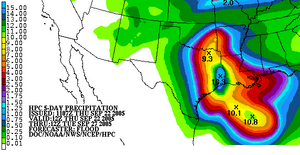Hydrometeorological Prediction Center facts for kids
The Hydrometeorological Prediction Center (HPC) is a special part of the National Weather Service in the United States. It helps forecast weather, especially about rain and snow. The HPC is part of a bigger group called the National Centers for Environmental Prediction (NCEP), which is part of the National Oceanic and Atmospheric Administration (NOAA). NOAA is a U.S. government agency that studies the ocean and atmosphere.
Contents
What Does the HPC Do for Weather?
The HPC is really good at predicting how much rain or snow will fall. This is called Quantitative Precipitation Forecasting. They also make weather forecasts for three to seven days ahead. The HPC helps understand information from complex computer models that predict weather. These models use lots of data to guess what the weather will be like.
How Does the HPC Help with Storms?
The HPC creates reports about big storm systems. These reports tell people about significant rainfall and snowfall across the United States. They also issue special warnings for tropical cyclones. These are storms like hurricanes that have moved inland. Once a tropical cyclone moves away from the coast, it becomes the HPC's job to track it.
The HPC also has a very important backup role. If the National Hurricane Center ever has a complete communication problem, the HPC steps in. It can take over the job of issuing hurricane warnings and advisories. This ensures that people always get important storm information.
When Was the HPC Created and Where Is It?
The HPC was created in October 1995. This happened when the former National Meteorological Center was reorganized into the NCEP. It is located in Camp Springs, Maryland. The HPC shares a building with other important weather centers. These include the Climate Prediction Center (CPC) and the Ocean Prediction Center (OPC). The Environmental Modeling Center (EMC) is also in the same building.
Images for kids



